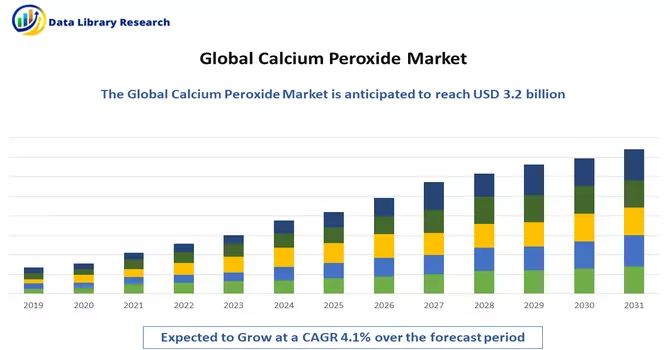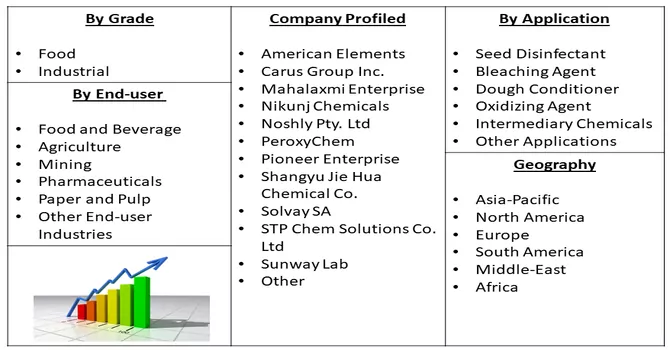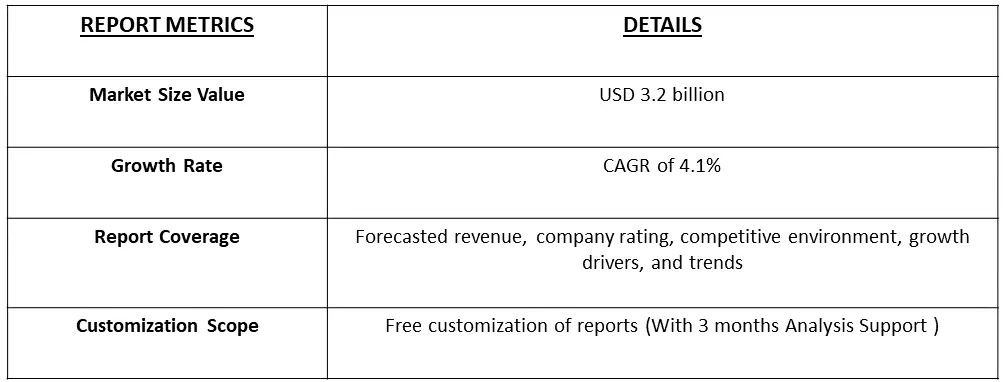The Calcium Peroxide Market was valued at USD 3.2 billion in 2023 and is anticipated to grow a CAGR of over 4.1% between 2024 and 2031.

Get Complete Analysis Of The Report - Download Free Sample PDF
Calcium peroxide, a versatile chemical compound, holds a prominent place in various industries, contributing to its widespread use and market significance. This inorganic peroxide is valued for its role as an oxygen release agent, finding applications in environmental remediation, agriculture, and the food industry. In environmental contexts, calcium peroxide is employed for soil and groundwater remediation, effectively releasing oxygen to enhance microbial activity and facilitate the degradation of contaminants. In agriculture, it serves as a slow-release source of oxygen, promoting soil aeration and root health. Additionally, the food industry utilizes calcium peroxide as a bleaching agent and dough conditioner. The compound's multifaceted applications underscore its importance, making calcium peroxide a valuable component across diverse sectors with a growing demand for environmentally friendly and sustainable solutions.
The growth of the calcium peroxide market is propelled by its increasing adoption in environmental remediation and agriculture, driven by a global demand for sustainable solutions. As a potent oxygen release agent, calcium peroxide plays a crucial role in soil and groundwater remediation by enhancing microbial activity, thereby expediting the degradation of pollutants. In agriculture, it serves as a slow-release source of oxygen, promoting soil aeration and fostering favorable conditions for root development. The escalating awareness of environmental sustainability and the need for innovative agricultural practices contribute to the expanding applications of calcium peroxide. Additionally, its role as a safe and effective dough conditioner and bleaching agent in the food industry further augments its market growth. The compound's versatility and eco-friendly characteristics position it as a key player in addressing contemporary challenges, driving the surge in demand across multiple sectors.
Market segmentation: The Calcium Peroxide Market report covers Revenue & Suppliers and is segmented by Grade (Food and Industrial), Application (Seed Disinfectant, Bleaching Agent, Dough Conditioner, Oxidizing Agent, Intermediary Chemicals, and Other Applications), End-user Industry (Food and Beverage, Agriculture, Mining, Pharmaceuticals, Paper and Pulp, and Other End-user Industries), and Geography (Asia-Pacific, North America, Europe, South America, and Middle-East and Africa).

For Detailed Market Segmentation - Download Free Sample PDF
The calcium peroxide market is currently witnessing notable trends that reflect the compound's increasing relevance in various industries. One significant trend is the growing emphasis on environmental sustainability, driving the adoption of calcium peroxide in soil and groundwater remediation projects. As regulatory scrutiny intensifies, industries are seeking eco-friendly alternatives for pollution control, elevating the demand for calcium peroxide. In agriculture, the trend towards sustainable farming practices, coupled with the compound's role as a soil conditioner, is contributing to its rising popularity. Moreover, the food industry is witnessing a shift towards cleaner label ingredients, propelling the use of calcium peroxide as a natural dough conditioner and bleaching agent. These trends underscore calcium peroxide's diverse applications and its pivotal role in addressing contemporary challenges across the environmental, agricultural, and food sectors, shaping the trajectory of the market.
Market Drivers:
In environmental applications, calcium peroxide serves as a potent oxygen-release agent, facilitating the remediation of contaminated soil and groundwater by enhancing microbial activity.
In environmental applications, calcium peroxide emerges as a powerful catalyst for the remediation of contaminated soil and groundwater, primarily through its role as a potent oxygen release agent. By facilitating the controlled release of oxygen, calcium peroxide creates an environment conducive to heightened microbial activity. This increased microbial presence is instrumental in accelerating the degradation of pollutants, effectively breaking down contaminants in the soil and groundwater. As a sustainable and eco-friendly solution, the use of calcium peroxide in environmental remediation projects has become increasingly significant, contributing to the restoration of ecosystems and the mitigation of environmental hazards. This unique capability positions calcium peroxide as a crucial element in the arsenal of tools aimed at addressing and resolving contamination challenges in diverse environmental settings.
The rising demand for sustainable agriculture practices fuels the use of calcium peroxide as a soil conditioner
The escalating demand for sustainable agricultural practices is propelling the utilization of calcium peroxide as a key soil conditioner. Recognized for its capacity as a slow-release oxygen source, calcium peroxide contributes to enhanced soil aeration, fostering optimal conditions for microbial activity. This, in turn, promotes nutrient availability and overall soil health, aligning with the global shift towards sustainable farming methods. As agriculture faces increasing pressure to adopt eco-friendly solutions, calcium peroxide emerges as a valuable tool for farmers striving to improve soil structure and fertility without compromising environmental integrity. Its role as a sustainable soil conditioner underscores its importance in modern agriculture, where the pursuit of environmentally conscious practices continues to drive the adoption of innovative and effective solutions for long-term soil health and crop productivity.
Market Restraints:
The calcium peroxide market faces certain constraints that impact its growth trajectory. One notable restraint is the regulatory scrutiny and compliance challenges associated with the use of calcium peroxide in various applications, particularly in environmental remediation. Strict regulations and approval processes may pose hurdles to market expansion, requiring manufacturers to navigate complex compliance requirements. Additionally, the cost of production and subsequent pricing of calcium peroxide can be a limiting factor, especially in agricultural applications where cost-effectiveness is a crucial consideration for farmers. Furthermore, despite its eco-friendly profile, public awareness and perception of chemical additives in agriculture and food industries can present challenges, potentially hindering broader market acceptance. Overcoming these regulatory, economic, and perception-related obstacles is essential for the calcium peroxide market to realize its full potential and gain widespread adoption across industries.
The calcium peroxide market, like many others, has not been immune to the impact of the COVID-19 pandemic. Disruptions in global supply chains, restrictions on manufacturing activities, and shifts in consumer priorities have collectively influenced the market dynamics. The pandemic-induced economic uncertainties led to a temporary slowdown in construction and industrial activities, affecting the demand for calcium peroxide in applications such as environmental remediation. Moreover, disruptions in logistics and transportation impacted the timely delivery of calcium peroxide to end-users. On the positive side, the heightened focus on food safety and security during the pandemic emphasized the need for effective and safe agricultural solutions, potentially driving demand for calcium peroxide in sustainable farming practices. As the world navigates the ongoing challenges posed by the pandemic, the calcium peroxide market is expected to recalibrate strategies and leverage emerging opportunities in a post-COVID landscape.
Segmental Analysis:
Industrial Segment is Expected to Witness Significant Growth Over the Forecast Period
Calcium peroxide is utilized across various industries for its ability to release oxygen gradually in controlled conditions. In environmental remediation, it enhances the growth of aerobic bacteria to degrade organic contaminants in groundwater and soil. In the food industry, it acts as a dough conditioner and flour bleaching agent, improving the texture and appearance of baked goods. In agriculture, it serves as an oxygen source for soil bioremediation and as a fertilizer, promoting the growth of beneficial microorganisms and improving soil aeration. Additionally, calcium peroxide finds application in water treatment to oxidize and remove contaminants, in animal feed to aid digestion, and in wastewater treatment to break down pollutants. Its versatility in releasing oxygen in a controlled manner makes it valuable in various industrial processes.
Dough Conditioner Segment is Expected to Witness Significant Growth Over the Forecast Period
Dough conditioners are additives used in baking to improve the strength and workability of dough, resulting in a better texture and volume in the finished product. Calcium peroxide is one such dough conditioner that is used to enhance the quality of baked goods. It works by releasing oxygen slowly during the mixing and fermentation process, which helps strengthen the gluten structure in the dough. This leads to improved dough elasticity and gas retention, resulting in a lighter and more uniform crumb in the final baked product. Additionally, calcium peroxide acts as a bleaching agent, whitening the flour and giving the baked goods a brighter appearance. Its use is particularly common in bread and pastry products where a light, airy texture is desired. Overall, calcium peroxide is a versatile dough conditioner that helps bakers achieve consistent and high-quality results.
Mining Segment is Expected to Witness Significant Growth Over the Forecast Period
Mining plays a critical role in the production of calcium peroxide, as it is extracted from natural mineral sources. Calcium peroxide is primarily produced by reacting calcium oxide (lime) with hydrogen peroxide. Lime, in turn, is derived from limestone, which is a sedimentary rock composed mainly of calcium carbonate. The mining process for limestone involves drilling, blasting, and crushing the rock to extract the calcium carbonate. Once extracted, the calcium carbonate is heated in a kiln to produce calcium oxide, which is then combined with hydrogen peroxide to produce calcium peroxide. The mining and production of calcium peroxide require careful consideration of environmental and safety regulations to minimize the impact on the surrounding ecosystem and ensure the safety of workers. Sustainable mining practices, such as reclamation of mined areas and responsible waste management, are essential to minimize the environmental footprint of calcium peroxide production.
North America Region is Expected to Witness Significant Growth Over the Forecast Period
North America is a significant market for calcium peroxide, driven by its wide range of industrial applications and the region's strong manufacturing base. Calcium peroxide is used in various industries in North America, including environmental remediation, food processing, agriculture, and wastewater treatment. In environmental applications, calcium peroxide is used to treat contaminated soil and groundwater, providing a cost-effective and environmentally friendly solution for cleaning up hazardous waste sites. In the food industry, it is used as a dough conditioner and a flour bleaching agent, improving the texture and appearance of baked goods. In agriculture, calcium peroxide is used as an oxygen source for soil bioremediation and as a fertilizer, promoting plant growth. Additionally, calcium peroxide is used in wastewater treatment to break down organic pollutants. The demand for calcium peroxide in North America is expected to grow as industries continue to seek environmentally sustainable solutions and as the region's manufacturing sector expands.
 \
\
Get Complete Analysis Of The Report - Download Free Sample PDF
The analyzed market exhibits a high degree of fragmentation, primarily attributable to the presence of numerous players operating on both a global and regional scale. The competitive landscape is characterized by a diverse array of companies, each contributing to the overall market dynamics. This fragmentation arises from the existence of specialized solution providers, established industry players, and emerging entrants, all vying for market share. The diversity in market participants is underscored by the adoption of various strategies aimed at expanding the company presence. On a global scale, companies within the studied market are strategically positioning themselves through aggressive expansion initiatives. This often involves entering new geographical regions, targeting untapped markets, and establishing a robust global footprint. The pursuit of global expansion is driven by the recognition of diverse market opportunities and the desire to capitalize on emerging trends and demands across different regions. Simultaneously, at the regional level, companies are tailoring their approaches to align with local market dynamics. Regional players are leveraging their understanding of specific market nuances, regulatory environments, and consumer preferences to gain a competitive edge. This regional focus allows companies to cater to the unique needs of local clientele, fostering stronger market penetration. To navigate the complexities of the fragmented market, companies are implementing a range of strategies. These strategies include investments in research and development to stay at the forefront of technological advancements, mergers and acquisitions to consolidate market share, strategic partnerships for synergies, and innovation to differentiate products and services. The adoption of such multifaceted strategies reflects the competitive nature of the market, with participants continually seeking avenues for growth and sustainability. In essence, the high fragmentation in the studied market not only signifies the diversity of players but also underscores the dynamism and competitiveness that drive ongoing strategic maneuvers. As companies explore various avenues for expansion, the market continues to evolve, presenting both challenges and opportunities for industry stakeholders. Some of the key market players working in this segment are:
Recent Development:
1) In December 2023, Salalah Free Zone signed an agreement for the establishment of a factory with a total investment of USD 65 million. The factory will produce caustic soda, calcium chloride, and ammonia chloride, essential ingredients in industries such as paper manufacturing, glass production, detergent making, and agricultural fertilizer production. This initiative is expected to significantly contribute to the calcium peroxide market. The production of calcium chloride, in particular, is a key component in the manufacturing process of calcium peroxide. As a result, the establishment of this factory is likely to increase the availability of calcium chloride, which is a crucial raw material for calcium peroxide production. This increased availability could potentially lead to a more competitive market for calcium peroxide, benefiting industries that rely on this chemical compound for various applications.
2) In November 2023, Evonik, a leading speciality chemicals company, announced plans to construct a new plant for ultra-high purity colloidal silica at its site in Weston, Michigan, USA. This investment, totalling USD 7.9 million in capital spending for 2023 and 2024, marks a significant development for the North American market. The plant, expected to be operational in 2024, will be the first of its kind in the region. Colloidal silica is a crucial raw material for the electronics and semiconductor industries, which are experiencing rapid growth due to the global demand for microchips and digital products. The establishment of this plant by Evonik is expected to have a positive impact on the calcium peroxide market. As colloidal silica is a key component in the production of calcium peroxide, increased availability of ultra-high purity colloidal silica in North America is likely to lead to a more competitive market for calcium peroxide. This development could benefit industries that rely on calcium peroxide for various applications, including environmental remediation, food processing, and agriculture, among others.
Q1. What was the Calcium Peroxide Market size in 2023?
As per Data Library Research the Calcium Peroxide Market was valued at USD 3.2 billion in 2023.
Q2. At what CAGR is the market projected to grow within the forecast period?
Calcium Peroxide Market is anticipated to grow a CAGR of over 4.1% over the forecast period.
Q3. What segments are covered in the Calcium Peroxide Market Report?
By Grade, By Application, By End-User and Geography these segments are covered in the Calcium Peroxide Market Report.
Q4. Which region has the largest share of the Calcium Peroxide market? What are the largest region's market size and growth rate?
North America has the largest share of the market. For detailed insights on the largest region's market size and growth rate request a sample here.
Data Library Research are conducted by industry experts who offer insight on industry structure, market segmentations technology assessment and competitive landscape (CL), and penetration, as well as on emerging trends. Their analysis is based on primary interviews (~ 80%) and secondary research (~ 20%) as well as years of professional expertise in their respective industries. Adding to this, by analysing historical trends and current market positions, our analysts predict where the market will be headed for the next five years. Furthermore, the varying trends of segment & categories geographically presented are also studied and the estimated based on the primary & secondary research.
In this particular report from the supply side Data Library Research has conducted primary surveys (interviews) with the key level executives (VP, CEO’s, Marketing Director, Business Development Manager and SOFT) of the companies that active & prominent as well as the midsized organization
FIGURE 1: DLR RESEARH PROCESS

Extensive primary research was conducted to gain a deeper insight of the market and industry performance. The analysis is based on both primary and secondary research as well as years of professional expertise in the respective industries.
In addition to analysing current and historical trends, our analysts predict where the market is headed over the next five years.
It varies by segment for these categories geographically presented in the list of market tables. Speaking about this particular report we have conducted primary surveys (interviews) with the key level executives (VP, CEO’s, Marketing Director, Business Development Manager and many more) of the major players active in the market.
Secondary ResearchSecondary research was mainly used to collect and identify information useful for the extensive, technical, market-oriented, and Friend’s study of the Global Extra Neutral Alcohol. It was also used to obtain key information about major players, market classification and segmentation according to the industry trends, geographical markets, and developments related to the market and technology perspectives. For this study, analysts have gathered information from various credible sources, such as annual reports, sec filings, journals, white papers, SOFT presentations, and company web sites.
Market Size EstimationBoth, top-down and bottom-up approaches were used to estimate and validate the size of the Global market and to estimate the size of various other dependent submarkets in the overall Extra Neutral Alcohol. The key players in the market were identified through secondary research and their market contributions in the respective geographies were determined through primary and secondary research.
Forecast Model
